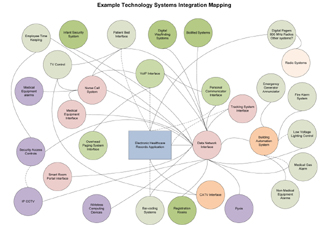
DJC.COM
April 23, 2009
When electronic systems 'talk,' patients, hospitals benefit
Sparling

|
The health care environment is a hotbed for technology. From electronic health care records and voice over internet protocol (VoIP) to nurse call systems and personal communication devices, the hospital provides a setting for use of a wide range of systems to optimize patient care.
While these technologies are powerful enablers in their own right, the integration of these tools bring advantages to hospitals that can help further enhance the delivery of patient care.
Defining integration
So what does "integration" really mean, and why is it so powerful? Integration can be loosely defined as the direct or indirect connection of technology systems to enable the sharing of common data. It provides a functionality between systems that enables each system to work more efficiently than if it stood alone.
Key reasons to seek systems integration in a hospital setting include:
* The opportunity to share databases. Fewer database entries mean fewer potential entry errors.
* The ability to access more data and records at a single portal.
* The ability to interactively share data with the patient at the bedside or through Web portals.
* The opportunity to provide interactive services to the patient such as educational content, pre-admission services, test results, menu based meals, and so on.
* Installation of fewer systems — less capital and long-term maintenance costs.
* The ability to gather data and results for tracking evidence-based medicine.
There are a number of systems that can potentially be linked together to improve efficiency. For example, today's hospital telephone system can perform a variety of different tasks, including intercom communication, code calling and interties with nurse call systems, security systems, pagers and network-based personal communicators. When these technologies are integrated with a VoIP network, they offer broader coverage and more direct communication.
The ability to integrate these various communication systems allows a more robust overall communication methodology in the hospital and allows systems to take advantage of other systems' capabilities to gain leverage, rather than trying to build and pay for separate standalone systems.
Integration scenarios
Integration of medical equipment with other systems such as electronic medical records is a developing field. The ability to port information directly from the medical equipment into an electronic patient record eliminates the human step of entering the information manually.
Technology will soon allow the integration of medical equipment with communication systems such as text messaging devices. This functionality can be used to alert the biomedical engineering department that the equipment has a problem, for example, and also log what that problem is, resulting in faster equipment repair.
Other linkages that can help eliminate duplicate systems and also provide higher quality information include:
Process automation. Just as the building-automation system automates the control of HVAC equipment, there are other automation tasks that can be done by linking systems. For instance, linking the building-automation system to a VoIP phone system or text message device can provide early warning to building engineering staff of equipment issues for preventative maintenance.
While this technology has been around for awhile, the ability to allow systems to "talk" with each other provides more diagnostic information and saves field time troubleshooting. Additional data allows maintenance staff to see exactly what's wrong with the equipment as opposed to receiving a basic "malfunction" alarm.
Schedule based controls. Systems such as electronic medical records can be linked with the building-automation system, allowing for automated control of energy systems. This could allow for the operating room's HVAC to be throttled on or off based on the room's schedule for the day, for example, allowing for tighter control of energy use.
Security and CCTV. Security systems and closed-circuit television have moved toward being IP-based systems that can integrate into the hospital's data network.
This opens up a wide area of integration between these systems and other information systems in the hospital. For instance, the electronic staff-timekeeping system database can be integrated into the access-control system so that there would be only one employee database used, and no need to create a separate one in the access-control system.
Access-control cards can be integrated with radio-frequency identification tracking systems so that a single card can be used for tracking as well as access control. Bar coding systems can be integrated with the access-control card, again providing a single-source card for multiple uses beyond security and access control. Closed-circuit TV can be integrated with mobile computing devices or PDAs to provide real-time camera images in the palm of your hand.
Dual use of fire alarm paging speakers. By creating a link between the hospital's telephone system and fire alarm system, the fire alarm paging system can also be used for everyday hospital-wide paging.
Assuming that fire alarm paging speakers are used (normally required in a high-rise building), this eliminates the need to install a separate paging system of speakers and amplifiers. In this type of system, priority will be given to fire alarm pages, which will override normal paging if a fire alarm page occurs.
Planning for integration really requires standing back from the individual systems in order to understand and create a vision of how systems will work together and what benefits and strategies make sense within a given hospital. It is best to think about integration by understanding the strengths and weaknesses of each individual system, then considering how the integration can fill in the weaknesses.
Systems integration is an extremely powerful tool when done well. It can bring added features to each individual system and, in the end, enhance the delivery of information and improve the quality of health care delivery for the patient.
Tom Leonidas Jr. is a health care practice leader and vice president at Sparling, a Seattle-based electrical and technology consulting firm that specializes in health care planning and design.
Other Stories:
- Rural hospitals can build wisely if they have a plan
- New health care construction: Always costly, rarely needed
- Hospital project prices falling, but it is still buyer beware
- Architects: Listen and learn from your clients
- Designing to get the most bang for your buck
- New air system could keep patients warmer and healthier
- Lean design cuts cost for Covington medical building
Copyright ©2009 Seattle Daily Journal and DJC.COM.
Comments? Questions? Contact us.
